- Home
- Fiberglass Fish Tank
Custom Fiberglass Fish Tank for Aquaculture and Aquariums
GangLong Fiberglass fish tank are custom built and available in a huge variety of shapes and sizes for a wide range of uses is easy to clean.
Fiberglass Fish Tank is a versatile and durable option for aquaculture and home aquariums, known for their robust construction and adaptability. GangLong Fiberglass provides customized services for Fiberglass Fish Tank,available in hundreds of standard sizes and shapesover , and can also be tailored to specific dimensions and configurations to meet individual needs. The tanks are constructed with a gel coat and have thick sidewalls that enhance their durability and make them easy to clean, ideal for raising various aquatic species such as tilapia, shrimp, and tropical fish.
The Fiberglass Fish Tank’s rigid 5-mm fiberglass composition, enhanced by rigid fiberglass tubing, not only ensures sturdiness but also facilitates easy cleaning and maintenance.They are designed to be nestable, which reduces shipping costs, making them an economical choice. Additionally, these tanks can be instantly transformed into functional systems by adding filtration modules, making them suitable for use as quarantine, holding, or grow-out systems for aquaculture facilities.
Fiberglass Fish Tank is suitable for both professional hatcheries and home setups, providing a reliable and efficient environment for aquatic life. Whether for large-scale aquaculture operations or enhancing a home with a custom aquarium, Fiberglass Fish Tanks provide a flexible and dependable solution that caters to a wide array of aquatic farming and hobbyist needs.
Simplifying Your Life: Key Functionalities

| Attribute | Details |
|---|---|
| Brand Name | GangLong Fiberglass |
| Material | Fiberglass, PVC, Glass, Acrylic, Plastic |
| Shape | Square, Round, Rectangular, Customized Shapes |
| Surface Treatment | Smooth |
| Feature | Eco-friendly, Anti-aging, Easy Cleaning, Durable, Transparent, Ultra Quiet, Sustainable, Easy Operation |
| Usage/Application | Fish Farming, Aquaculture, Fish Pond, Swimming Pool, Fishing Ground, Dining Room, Living Room, Outdoor Spaces |
| Customization | Size, Thickness, Bottom Cabinet Color, Shape, Volume |
| Capacity/Volume | Customizable |
| Style/Design | Elegant, Modern, Suitable for Dining Rooms, Living Rooms, Outdoor, and Luxury Spaces |
| Warranty | 1 Year (for certain models), 10 Years (for specific acrylic tanks) |
| Certification | ISO9001 |
| Processing Service | Bending, Moulding, Punching, Cutting |
| Special Features | - Intelligent systems |
| Room Space Selection | Living Room, Dining Room, Outdoor Spaces, Luxury Homes |
| Packaging | - PE film to avoid scratches |
| - Bubble Wrap for crack protection | |
| - Wooden Box/Iron Frame | |
| - 5-7 layers of cartons with film and angle protection | |
| Place of Origin | Hebei, China |
| Supply Ability | 50 pieces per month (specific products) |
| Accessories | Includes filters, water pumps, and customizable bottom cabinets (specific products) |
| Commercial Buyer | Luxury homes, aquaculture enthusiasts, and aquarium businesses |
| Season | All-Season |
| Key Selling Points | - Professional design and manufacturing |
| - Customization options | |
| - Durable and high-quality materials | |
| - Easy maintenance | |
| - Elegant designs for various environments | |
| - Extensive packaging protection |
News
- Exploring the Benefits of Carbon Fiber Apparel
- How to Work with Carbon Fiber Successfully
- Carbon Fiber Suit: The Future of Lightweight Armor
- Is Carbon Fiber Armor the Future of Protection?
- Why White Carbon Fiber is Popular in Automotive Design
- Transparent Carbon Fiber Sheets: Strength Meets Clarity in Design
- Chopped Carbon Fiber Mat for Lightweight Reinforcement
- Carbon Fiber EG Hatch: Upgrade Your Civic Today
- The Benefits of Using Structural Carbon Fibre in Engineering
- How Many Layers of Layered Carbon Fiber Are Needed?
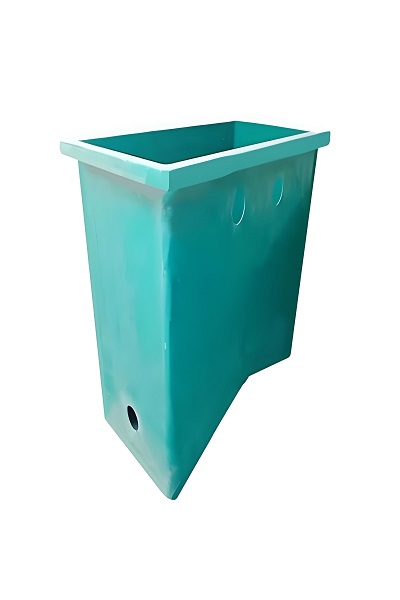
What are Fiberglass Fish Tanks?
What Makes Fiberglass a Superior Material?
A Fiberglass Fish Tank stands out as an exceptional choice due to the unique properties of fiberglass. Fiberglass is renowned for its durability, making it resistant to cracks, impacts, and general wear and tear over time. This strength is particularly beneficial in environments where the tank might be subject to heavy use or shifting loads, such as in commercial aquaculture settings. Another key advantage of fiberglass is its lightweight nature, which simplifies transportation, installation, and repositioning compared to heavier materials like glass or concrete. Additionally, fiberglass is inherently resistant to corrosion, meaning a Fiberglass Fish Tank will not degrade when exposed to water, chemicals, or salt, making it ideal for both freshwater and marine environments.
When compared to other materials like glass and acrylic, fiberglass offers several advantages. Unlike glass, which is prone to shattering under stress, fiberglass can absorb impacts without breaking. While acrylic is also durable, it is more susceptible to scratching, whereas fiberglass maintains its surface integrity better over time. Furthermore, fiberglass can be molded into a variety of shapes and sizes, and when combined with molded fiberglass insulation, it provides greater flexibility in tank design and customization.
A fiberglass fish tank with a window is a large, durable aquarium structure designed for fish-keeping and marine displays, often used in homes, public aquariums, research facilities, and zoos. Here is a detailed description: 1.Material and Construction: The tank is primarily constructed from high-quality fiberglass, a lightweight yet extremely strong and durable material. Fiberglass resists corrosion and is unaffected by prolonged exposure to water, making it ideal for aquariums. Inside, it is coated with a smooth, non-toxic, waterproof layer that prevents leaks and provides a safe, inert environment for fish and other aquatic life. The fiberglass structure can be custom-molded into various shapes and sizes, ranging from compact household models to large, panoramic tanks for commercial use. 2.Viewing Window: A prominent feature of this tank is its clear, impact-resistant viewing window, typically made of tempered glass or acrylic. This material allows unobstructed views of the fish and aquatic scenery within, enhancing the experience for viewers. The window is seamlessly integrated into the fiberglass tank to maintain water-tightness and structural integrity. Acrylic windows are often preferred for their high transparency, lightweight nature, and durability against scratches and impact. 3.Design and Shape Options: Fiberglass fish tanks with windows are available in various shapes, such as rectangular, cylindrical, or custom-designed models, to fit different environments and display preferences. They may also have multiple viewing panels or a single large panoramic window for 360-degree views, ideal for centerpieces in homes or exhibits. 4.Features and Accessories: Many fiberglass tanks come with built-in filtration systems, aeration, and lighting features that mimic natural light cycles, creating a healthy, appealing environment for fish and plants. Additional options like heating systems, dividers, and feeding ports are often available, tailored to the needs of specific fish species or environmental conditions. 5.Advantages: Fiberglass tanks are known for their lightweight construction compared to glass, making installation and relocation easier. They are highly resistant to temperature fluctuations, which helps in maintaining stable water conditions. The viewing window adds aesthetic appeal, allowing for immersive viewing experiences while maintaining the durability and longevity associated with fiberglass construction. These tanks are popular for their versatility, durability, and customizable options, making them suitable for both private collectors and large-scale aquatic exhibits. Fiberglass Fish Tanks are a versatile and durable option for aquaculture and home aquariums, known for their robust construction and adaptability. GangLong Fiberglass provides customized services for Fiberglass Fish Tank,available in hundreds of standard sizes and shapesover , and can also be tailored to specific dimensions and configurations to meet individual needs. The tanks are constructed with a gel coat and have thick sidewalls that enhance their durability and make them easy to clean, ideal for raising various aquatic species such as tilapia, shrimp, and tropical fish. Fiberglass Fish Tank’ rigid 5-mm fiberglass composition not only ensures sturdiness but also facilitates easy cleaning and maintenance. They are designed to be nestable, which reduces shipping costs, making them an economical choice. Additionally, these tanks can be instantly transformed into functional systems by adding filtration modules, making them suitable for use as quarantine, holding, or grow-out systems for aquaculture facilities. Fiberglass Fish Tank is suitable for both professional hatcheries and home setups, providing a reliable and efficient environment for aquatic life. Whether for large-scale aquaculture operations or enhancing a home with a custom aquarium, Fiberglass Fish Tanks provide a flexible and dependable solution that caters to a wide array of aquatic farming and hobbyist needs.Benefits of Fiberglass Fish Tanks
Fiberglass Fish Tank Price
Factors Influencing Price
The price of a Fiberglass Fish Tank can vary significantly based on several key factors. One of the most influential factors is the size of the tank. Larger tanks, such as those used in commercial aquaculture or large home aquariums, require more materials and labor, which naturally increases the cost. Customization options, such as the inclusion of windows, unique shapes, or specialized filtration systems, also contribute to the overall price. Tanks with viewing windows or complex shapes require additional manufacturing steps and materials, making them more expensive than standard rectangular or round tanks.
The quality and thickness of the materials used are other critical factors that influence the price. Higher-grade fiberglass and thicker layers of resin will provide greater durability and resistance to damage, but they also come at a higher cost. Additionally, the reputation of the brand and the manufacturing process itself can impact the price. Tanks from well-known manufacturers with a track record of quality and reliability may be priced higher than those from lesser-known brands. The manufacturing process, particularly if it involves advanced techniques such as vacuum infusion or autoclave curing, can also affect the cost due to the precision and expertise required.
When considering the cost of a Fiberglass Fish Tank, it’s important to understand the typical price ranges for different sizes and configurations. For small home aquariums, prices can start as low as $200 to $500, depending on the tank’s size and features. These smaller tanks are generally straightforward in design and do not include extensive customization options. For mid-sized tanks, often used in both residential and commercial settings, prices can range from $1,000 to $5,000. These tanks may include additional features such as viewing windows or reinforced structures to support larger volumes of water. Larger tanks, such as 1000-gallon fiberglass fish tanks used in commercial aquaculture, can range from $10,000 to $20,000 or more. These tanks often require custom designs to accommodate specific needs and may include specialized filtration systems, multiple access points, and reinforced construction to ensure durability under heavy use. When comparing prices between custom and pre-fabricated fiberglass tanks, custom options are generally more expensive due to the tailored design and additional labor involved. However, custom tanks offer the advantage of being specifically engineered to meet unique requirements, which can be critical for certain applications. Pre-fabricated tanks, on the other hand, are more cost-effective and readily available, making them a practical choice for those with standard needs.Typical Price Ranges
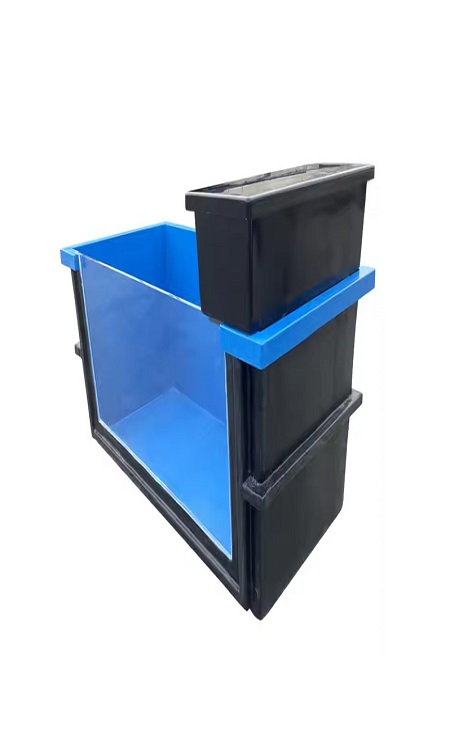
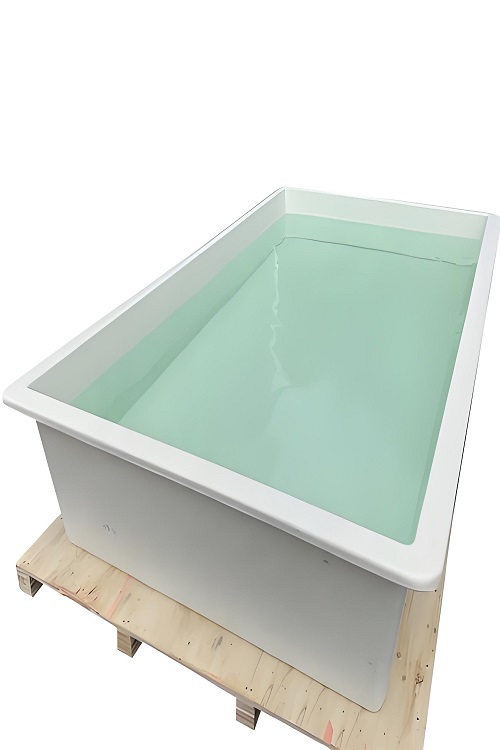
Custom Fiberglass Fish Tank Shapes and Sizes
A custom fiberglass fish tank offers a unique, durable, and versatile option for both personal and commercial settings. Fiberglass is often chosen for its strength, lightweight nature, and ability to be molded into a wide variety of shapes and sizes, making it an ideal material for creating custom tanks. Below is a detailed look into the various shapes, sizes, and benefits of custom fiberglass fish tanks:
Customizable Shapes
One of the greatest advantages of fiberglass tanks is their ability to be molded into virtually any shape. This makes them perfect for custom designs, whether you’re creating a traditional rectangular tank, an organic, flowing shape, or even a complex curved design.
Rectangular Tanks: Standard in many settings, these are the most common and easily customizable in terms of dimensions. They provide easy access for fish care and allow for a classic, streamlined look.
Hexagonal and Octagonal Tanks: These polygonal shapes are popular in both home and commercial aquariums for their unique appearance. They allow for more viewing angles, making the fish and aquatic plants visible from various sides.
Cylinder or Circular Tanks: Offering a 360-degree viewing experience, these tanks provide a unique and striking focal point in any room. They are often used for display purposes, giving an unobstructed view of the underwater environment.
Freeform or Organic Shapes: Fiberglass allows for more natural, curved, and flowing designs that mimic the shape of rocks, caves, or natural water features. These can be used for more artistic and visually engaging aquariums, especially in public or custom-designed spaces.
Fiberglass can be molded into any size to suit specific space requirements. This means you can have a fish tank that fits perfectly in a corner, along a wall, or even as a freestanding feature. Custom sizes are beneficial in both residential and commercial settings, as they can cater to specific fish species or the aesthetic requirements of the space. Small Tanks: For personal use or smaller spaces, custom fiberglass tanks can be designed to hold a variety of fish while taking up minimal space. These could range from compact desktop tanks to small, tabletop aquariums. Medium-Sized Tanks: Ideal for hobbyists who wish to keep a variety of fish species, these tanks offer more flexibility in terms of stocking and aquascaping. Common sizes include tanks holding between 50 to 200 gallons. Large Tanks: Custom fiberglass tanks are especially popular for large installations. This could include tanks that hold over 200 gallons, perfect for large fish or marine setups. Custom large tanks are often seen in public aquariums, hotels, restaurants, and other commercial spaces where the visual impact is important. Floor-to-Ceiling Tanks: These large, impressive designs can be custom made to span entire walls, providing a stunning visual centerpiece. They can be shaped to fit the specific dimensions of a space, giving the appearance of an aquarium embedded within the structure of a room. Custom fiberglass fish tanks can come with a variety of optional features: Built-in Filtration Systems: Many custom fiberglass tanks can include built-in filtration systems, which help to maintain water quality by removing waste and debris. This feature is often incorporated during the design phase for seamless integration. Integrated Lighting Systems: Lighting is essential for both aesthetic appeal and the health of aquatic life. Custom tanks can be equipped with LED lighting that is specifically tailored to the needs of the fish and plants being kept. Exotic Features: For an even more bespoke setup, fiberglass tanks can incorporate elements like waterfalls, integrated filtration systems, caves, or custom backgrounds that enhance the aesthetic and functionality of the tank. Custom fiberglass fish tanks offer a unique combination of durability, versatility, and aesthetic appeal. Their ability to be molded into virtually any shape or size means they can be tailored to meet the specific needs of both hobbyists and commercial users. Whether you’re looking for a small, sleek aquarium for your living room or a massive display tank for a commercial space, fiberglass offers an ideal solution with a long-lasting, visually striking result. The cost of custom fiberglass fish tanks varies depending on the size, shape, and features selected. Generally, fiberglass is more expensive than traditional glass or acrylic tanks, but the durability and customization options make it a worthwhile investment. The cost will also be influenced by the complexity of the design and the additional features incorporated into the tank. Each of these shapes and sizes serves specific functional and aesthetic needs, allowing fiberglass tanks to be used in a wide range of environments, from personal aquariums to massive public displays.Customizable Sizes
Additional Features
Cost Considerations
Size Considerations
Fiberglass Fish Tank Range of Applications
Fiberglass fish tanks offer versatility and durability, making them suitable for a wide range of applications across various industries and settings. Here’s a detailed look at some of the primary applications for fiberglass fish tanks:
1. Residential Use
- Home Aquariums: Many homeowners choose fiberglass tanks for personal aquariums due to their durability, ease of customization, and aesthetic appeal. These tanks are often placed in living rooms, home offices, or as decorative centerpieces in larger homes.
- Custom Home Installations: Fiberglass tanks can be custom-built to fit specific spaces, like wall-mounted tanks, corner units, or even freestanding centerpieces.
2. Public Aquariums and Zoos
- Large Displays: Fiberglass tanks are frequently used in public aquariums and zoos for large-scale aquatic exhibits. The durability and customizable shapes of fiberglass allow for unique viewing experiences, such as tunnel tanks and large, panoramic wall tanks.
- Themed Exhibits: Public aquariums often use fiberglass tanks to create themed habitats, showcasing different ecosystems like coral reefs, freshwater rivers, and open-ocean environments.
These advantages make fiberglass fish tanks an excellent choice for a broad range of applications, from private home installations to large-scale public exhibits and industrial use.3. Hotels and Resorts
4. Educational Institutions
5. Healthcare and Therapeutic Environments
6. Retail and Commercial Displays
7. Restaurants and Dining Spaces
8. Industrial and Aquaculture Use
9. Luxury Yachts and Cruise Ships
10. Event Rentals and Themed Installations
Summary of Benefits in Various Applications
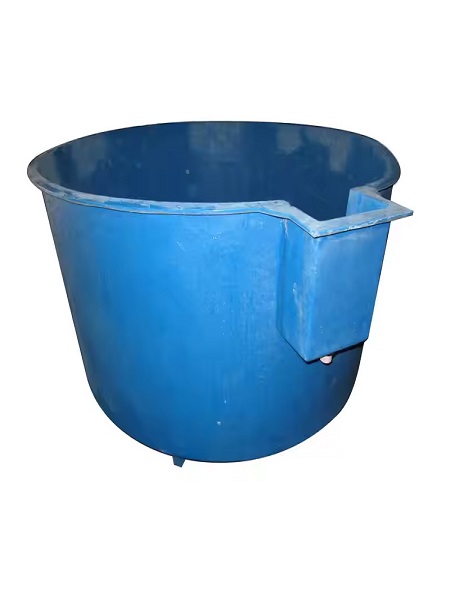
Thank you for your interest in our products. To receive our pricelist or for any inquiries, please fill out the form below. We will get back to you within 24 hours.
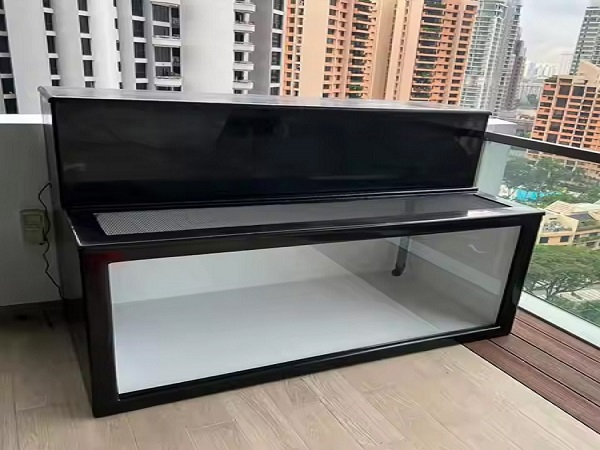
Fiberglass Fish Tank with Window
Advantages of Adding a Viewing Window
A Fiberglass Fish Tank with Window offers numerous advantages, particularly in enhancing the overall experience of observing and interacting with the aquatic environment. The addition of a viewing window allows for clear, unobstructed visibility into the tank, making it easier to observe the behavior and health of the fish and other aquatic life. This feature is especially valuable in both public exhibits and private home displays, where the ability to see into the tank from different angles adds a dynamic visual element.
The aesthetic appeal of a Fiberglass Fish Tank with Window cannot be overstated. It transforms a standard tank into a focal point, creating a stunning display that captivates viewers. In public exhibits, such as in aquariums or educational facilities, these tanks allow visitors to engage more closely with the aquatic environment, providing an immersive experience. In a home setting, a tank with a viewing window can serve as a beautiful centerpiece, enhancing the ambiance of the room and providing a serene, living art piece.
Installing a Fiberglass Fish Tank with Window requires careful planning and precision to ensure both the integrity of the tank and the clarity of the viewing experience. When installing the tank, it’s crucial to position the window in a way that optimizes visibility while also considering the structural requirements. The window should be securely bonded to the fiberglass frame using high-quality, marine-grade sealants to prevent leaks and ensure long-term durability. It’s also important to ensure that the tank is placed in a location where it can be easily accessed for maintenance, as well as in an area that takes advantage of natural or artificial lighting to enhance the viewing experience. Maintaining the clarity and cleanliness of the window is essential for keeping the tank looking its best. Regular cleaning with non-abrasive materials is recommended to avoid scratching the surface of the window. Use a soft cloth or sponge, along with a cleaner that is safe for both the window material and the aquatic life inside the tank. Avoid using harsh chemicals that could damage the window or harm the tank’s inhabitants. For stubborn algae or mineral deposits, consider using a plastic scraper designed specifically for aquarium maintenance. Regularly check the seals around the window to ensure they remain intact and watertight, and reapply sealant if any signs of wear or deterioration are noticed. By following these installation and maintenance tips, a Fiberglass Fish Tank with Window can provide a clear, engaging view of the aquatic environment, enhancing both the functionality and the aesthetic appeal of the tank. Whether used in a public setting or as part of a private collection, the addition of a viewing window offers a unique and visually striking way to enjoy the beauty of underwater life.Installation and Maintenance Tips
Fiberglass Fish Tank Kits
What’s Included in a Fiberglass Fish Tank Kit?
A Fiberglass Fish Tank Kit typically comes with all the essential components needed to set up and maintain a functional and aesthetically pleasing aquarium. These kits are designed to simplify the process of creating a complete aquatic environment, making them an excellent choice for both beginners and experienced aquarists.
Most Fiberglass Fish Tank Kits include the following components:
Fiberglass Tank: The centerpiece of the kit, the fiberglass tank is durable, lightweight, and resistant to corrosion, making it ideal for various aquatic environments.
Filtration System: A high-quality filtration system is usually included to keep the water clean and clear, ensuring a healthy environment for the fish. This system typically consists of mechanical, biological, and chemical filtration components.
Water Pump: Many kits include a water pump to circulate water, maintain oxygen levels, and create water movement that mimics natural aquatic environments.
Tank Stand: A sturdy stand designed to support the weight of the filled tank is often part of the kit. These stands are typically made to match the tank’s size and design, providing both functionality and aesthetic appeal.
Lighting: Some kits come with integrated lighting systems, which are essential for both plant growth and showcasing the beauty of the tank’s inhabitants. The lighting can range from basic fluorescent lights to advanced LED systems with customizable settings.
Heater: For tropical fish tanks, a heater is often included to maintain a stable water temperature, which is crucial for the health and well-being of the fish.
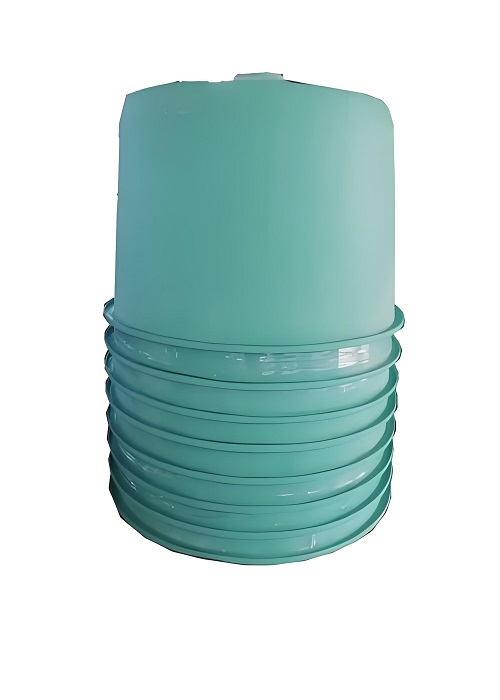
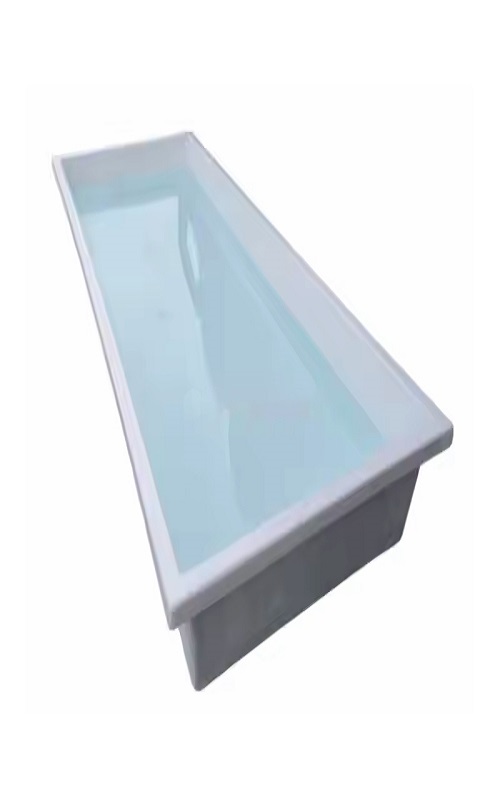
Fiberglass Fish Tank 1000 Gallon
Why Choose a 1000-Gallon Tank?
Opting for a Fiberglass Fish Tank 1000 Gallon offers significant advantages, especially for those involved in aquaculture, large-scale aquariums, or ambitious home setups. The most notable benefit of a larger tank is its capacity to maintain a stable aquatic environment. In a 1000-gallon tank, fluctuations in water temperature, pH, and other critical parameters occur more gradually, reducing stress on fish and other aquatic life. This stability is crucial for breeding programs, research facilities, and commercial aquariums, where maintaining optimal conditions is essential for the health and well-being of the species housed.
A larger Fiberglass Fish Tank also provides more space for fish to thrive, allowing for the accommodation of a greater number of species or larger fish that require more room to swim. This is particularly important in commercial aquariums and public exhibits, where the goal is often to create visually impressive displays that mimic natural habitats. Additionally, a 1000-gallon tank offers more opportunities for complex aquascaping, enabling the creation of diverse underwater landscapes that enhance the aesthetic appeal and educational value of the exhibit.
However, installing a Fiberglass Fish Tank 1000 Gallon requires careful planning due to its size and weight. The space must be large enough to accommodate the tank, with consideration given to accessibility for maintenance and viewing. The structural integrity of the floor or platform supporting the tank is another critical factor. A 1000-gallon tank, when filled with water, can weigh over 8,000 pounds, necessitating a robust foundation to prevent any risk of collapse or damage.
The Fiberglass Fish Tank 1000 Gallon is versatile and well-suited for various applications, ranging from commercial and public aquariums to research and educational facilities, and even for use in large-scale home installations. In commercial aquariums, a 1000-gallon tank can serve as the centerpiece of an exhibit, housing large species such as sharks, rays, or schools of fish that require ample space. These tanks can be customized with viewing windows, integrated filtration systems, and advanced lighting to create an immersive experience for visitors, enhancing the educational and entertainment value of the exhibit. Research facilities often utilize large tanks like the 1000-gallon Fiberglass Fish Tank for studies involving marine biology, ecology, or aquaculture. The generous size allows for the simulation of natural habitats, providing researchers with a controlled environment to observe behaviors, breeding patterns, and the effects of various environmental factors on aquatic life. The durability and chemical resistance of fiberglass make it an ideal material for these demanding applications, ensuring long-term performance and reliability. For large home installations, a 1000-gallon tank offers the opportunity to create a stunning private aquarium that rivals those found in public exhibits. Homeowners with the space and budget can design a custom tank to showcase exotic species or create a tranquil underwater landscape that serves as a focal point in their living space. The size of the tank allows for greater creativity in design and stocking options, making it a rewarding investment for serious aquarists.Applications of 1000-Gallon Tanks
Fiberglass Aquaculture Tanks
Specialized Use in Aquaculture
A Fiberglass Fish Tank is an essential tool in the field of aquaculture, providing a durable and versatile solution for fish farming and breeding operations. These tanks are widely used in both freshwater and marine aquaculture due to their excellent properties, which help maintain optimal water quality and support the health and growth of aquatic species. The non-reactive nature of fiberglass ensures that the tank does not leach harmful chemicals into the water, making it safer for sensitive species and allowing for more precise control over water chemistry.
In aquaculture, maintaining water quality is paramount, and fiberglass tanks excel in this area. Their smooth, non-porous surface resists the buildup of algae, bacteria, and other contaminants, making them easier to clean and sanitize. This helps to reduce the risk of disease outbreaks, which can be devastating in a high-density farming environment. Moreover, fiberglass is highly resistant to corrosion and chemical exposure, making it suitable for use with various treatments and supplements often required in aquaculture operations.
The strength and durability of a Fiberglass Fish Tank make it particularly well-suited for the rigorous demands of aquaculture. These tanks can withstand the physical stress of large volumes of water, frequent cleaning, and the activity of fish within the tank, all while maintaining their structural integrity over many years of use. Additionally, fiberglass’s lightweight nature compared to materials like concrete makes installation and relocation easier, offering flexibility in the design and expansion of aquaculture facilities.
One of the key advantages of using a Fiberglass Fish Tank in aquaculture is the ability to customize the tank to meet specific needs. Aquaculture operations often require tanks that are tailored to the species being farmed, the size of the operation, and the environmental conditions in which the tanks will be used. Fiberglass is highly adaptable and can be molded into various shapes and sizes, allowing for the creation of tanks that are optimized for the particular requirements of different aquatic species. For instance, tanks can be designed with specific dimensions and depths to accommodate the natural behaviors of the species being farmed. Shallow, wide tanks might be ideal for species that thrive in such environments, while deeper tanks may be necessary for species that prefer to swim in vertical water columns. Additionally, the internal design of the tank can include features such as partitions, flow channels, or integrated filtration systems to enhance water circulation and ensure that all areas of the tank are adequately aerated and filtered. Environmental conditions, such as temperature and water chemistry, can also be factored into the customization of a Fiberglass Fish Tank. Tanks can be equipped with insulation to maintain stable water temperatures or designed to accommodate specific filtration and heating systems that ensure the water remains within the optimal range for the species being farmed. Furthermore, the surface finish of the tank can be customized to minimize stress on the fish, with smooth surfaces to prevent injury or specialized coatings that reduce reflection and improve light diffusion. Customization extends beyond just the physical design of the tanks. Fiberglass tanks can also be outfitted with advanced monitoring systems that track water quality parameters in real-time, allowing aquaculture operators to respond quickly to any changes and maintain optimal conditions for their stock. This level of customization is essential for achieving high productivity and efficiency in modern aquaculture operations, where every aspect of the environment must be carefully controlled to maximize growth rates and ensure the health of the fish.Customization for Aquaculture Needs
FAQs about Fiberglass Fish Tank
Is fiberglass safe for fish?
Is fiberglass good for water tanks?
What is the best material for a fish tank?
Is fiberglass safe for aquariums?
Are fibreglass water tanks safe?
Does fiberglass leach into water?
Does fiberglass react with water?
How do you maintain a fiberglass water tank?
Can fiberglass be used underwater?
How do you clean a fiberglass fish tank?
Is fibreglass non toxic?
Is fiberglass toxic to the environment?
Is fiberglass poisonous to fish?
Is fiberglass safe for animals?
What are the disadvantages of fibreglass tanks?
Is fiberglass resistant to water?
Is Fibreglass safe for fish?
Does fibreglass stay in your lungs?
What is the risk of fibreglass?
Can fiberglass withstand water?
Is fibreglass a hazardous material?
Does fibreglass mold?
Does fibreglass corrode?
What are the disadvantages of fiberglass water tanks?
What is the healthiest water tank?
Are fiberglass tanks safe for drinking water?
What are the problems with fiberglass?
What are the pros and cons of fibreglass?
Durability: Fiberglass is resistant to rust, corrosion, and many chemicals.
Strength: It has a high strength-to-weight ratio, making it suitable for large, structural applications.
Versatility: Fiberglass can be molded into various shapes and sizes.
Thermal and Electrical Insulation: It provides good thermal and electrical insulating properties.
Longevity: With proper maintenance, fiberglass products can last for decades.
Cons:
Cost: Fiberglass can be more expensive than other materials like plastic or steel.
Impact Vulnerability: It can crack or splinter under heavy impact.
UV Degradation: Requires protective coatings to prevent UV-induced deterioration.
Handling Risks: The fibers can cause skin irritation and respiratory issues during manufacturing or repair.
Maintenance: Requires regular inspection and maintenance to ensure safety and longevity.
Do fiberglass tanks leak?
Does fiberglass degrade in water?
Do fiberglass tanks need grounding?
What is the life expectancy of a GRP water tank?
Which is better fiberglass or polyethylene tanks?
Fiberglass Tanks: They are stronger, more durable, and resistant to a wider range of chemicals and temperatures compared to polyethylene. They can be customized to various sizes and shapes and have a longer lifespan. However, they are more expensive and require more maintenance.
Polyethylene Tanks: These tanks are more affordable, lighter, and easier to install. They are highly resistant to corrosion and UV light if treated properly. However, they have lower tensile strength and may not be suitable for extreme conditions or highly corrosive substances. They also have a shorter lifespan compared to fiberglass tanks.
In general, fiberglass tanks are better suited for industrial applications that require high strength, chemical resistance, and longevity, while polyethylene tanks are often preferred for residential or light commercial use due to their lower cost and ease of handling.
Do fiberglass tanks need to have protection from corrosion?
What is the best material for a water storage tank?
Stainless Steel: Ideal for potable water storage due to its corrosion resistance, durability, and non-toxic nature.
Fiberglass (GRP): Suitable for a wide range of water storage needs, including potable and industrial applications, due to its strength, durability, and chemical resistance.
Polyethylene: Cost-effective and lightweight, suitable for residential and light commercial use.
Concrete: Used for large, underground water storage systems; offers durability and thermal insulation but can be prone to cracking.
Fiberglass is often chosen for its balance of strength, durability, and resistance to corrosion and UV degradation. However, stainless steel is preferred for applications requiring the highest purity and hygiene standards, such as drinking water storage.
What is the life expectancy of a fiberglass tank?
Can fiberglass tanks be repaired?
Is fiberglass life threatening?
How much does it cost to have a fiberglass tank?
Are fiberglass well tanks good?
How many years will a fish tank last?
Can a hot water tank last 30 years?
How strong are fiberglass tanks?
Thank you for your interest in our products. To receive our pricelist or for any inquiries, please fill out the form below. We will get back to you within 24 hours.
